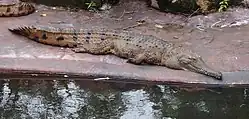Portal:Reptiles
Portal maintenance status: (June 2018)
|
The Reptiles Portal
Reptiles, as commonly defined, are a group of tetrapods with an ectothermic metabolism and amniotic development. Living traditional reptiles comprise four orders: Testudines, Crocodilia, Squamata, and Rhynchocephalia. About 12,000 living species of reptiles are listed in the Reptile Database. The study of the traditional reptile orders, customarily in combination with the study of modern amphibians, is called herpetology.
Reptiles have been subject to several conflicting taxonomic definitions. In evolutionary taxonomy, reptiles are gathered together under the class Reptilia (/rɛpˈtɪliə/ rep-TIL-ee-ə), which corresponds to common usage. Modern cladistic taxonomy regards that group as paraphyletic, since genetic and paleontological evidence has determined that crocodilians are more closely related to birds (class Aves), members of Dinosauria, than to other living reptiles, and thus birds are nested among reptiles from a phylogenetic perspective. Many cladistic systems therefore redefine Reptilia as a clade (monophyletic group) including birds, though the precise definition of this clade varies between authors. A similar concept is clade Sauropsida, which refers to all amniotes more closely related to modern reptiles than to mammals.
The earliest known proto-reptiles originated from the Carboniferous period, having evolved from advanced reptiliomorph tetrapods which became increasingly adapted to life on dry land. The earliest known eureptile ("true reptile") was Hylonomus, a small and superficially lizard-like animal which lived in Nova Scotia during the Bashkirian age of the Late Carboniferous, around 318 million years ago. Genetic and fossil data argues that the two largest lineages of reptiles, Archosauromorpha (crocodilians, birds, and kin) and Lepidosauromorpha (lizards, and kin), diverged during the Permian period. In addition to the living reptiles, there are many diverse groups that are now extinct, in some cases due to mass extinction events. In particular, the Cretaceous–Paleogene extinction event wiped out the pterosaurs, plesiosaurs, and all non-avian dinosaurs alongside many species of crocodyliforms and squamates (e.g., mosasaurs). Modern non-bird reptiles inhabit all the continents except Antarctica. (Full article...)
Reptile types
-
 Image 1
Image 1 Nile crocodile (Crocodylus niloticus)
Nile crocodile (Crocodylus niloticus)
Crocodiles (family Crocodylidae) or true crocodiles are large, semiaquatic reptiles that live throughout the tropics in Africa, Asia, the Americas and Australia. The term "crocodile" is sometimes used more loosely to include all extant members of the order Crocodilia, which includes the alligators and caimans (both members of the family Alligatoridae), the gharial and false gharial (both members of the family Gavialidae) as well as other extinct taxa. (Full article...) -
 Image 2
Image 2_male.jpg) Male gharial
Male gharial
The gharial (Gavialis gangeticus), also known as gavial or fish-eating crocodile, is a crocodilian in the family Gavialidae and among the longest of all living crocodilians. Mature females are 2.6 to 4.5 m (8 ft 6 in to 14 ft 9 in) long, and males 3 to 6 m (9 ft 10 in to 19 ft 8 in). Adult males have a distinct boss at the end of the snout, which resembles an earthenware pot known as a ghara, hence the name "gharial". The gharial is well adapted to catching fish because of its long, narrow snout and 110 sharp, interlocking teeth. (Full article...) -
 Image 3
Image 3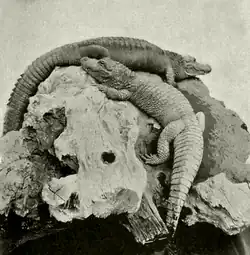 1905 photograph of an American alligator (top) and a Chinese alligator (bottom)
1905 photograph of an American alligator (top) and a Chinese alligator (bottom)
An alligator, or colloquially gator, is a large reptile in the genus Alligator of the family Alligatoridae in the order Crocodilia. The two extant species are the American alligator (A. mississippiensis) and the Chinese alligator (A. sinensis). Additionally, several extinct species of alligator are known from fossil remains. Alligators first appeared during the late Eocene epoch about 37 million years ago. (Full article...) -
 Image 4
Image 4
Turtles are reptiles of the order Testudines, characterized by a special shell developed mainly from their ribs. Modern turtles are divided into two major groups, the Pleurodira (side necked turtles) and Cryptodira (hidden necked turtles), which differ in the way the head retracts. There are 360 living and recently extinct species of turtles, including land-dwelling tortoises and freshwater terrapins. They are found on most continents, some islands and, in the case of sea turtles, much of the ocean. Like other amniotes (reptiles, birds, and mammals) they breathe air and do not lay eggs underwater, although many species live in or around water. (Full article...) -
 Image 5
Image 5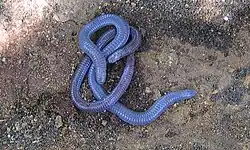 Blanus cinereus, Spain
Blanus cinereus, Spain
Amphisbaenia /æmfɪsˈbiːniə/ (called amphisbaenians or worm lizards) is a group of typically legless lizards, comprising over 200 extant species. Amphisbaenians are characterized by their long bodies, the reduction or loss of the limbs, and rudimentary eyes. As many species have a pink body and scales arranged in rings, they have a superficial resemblance to earthworms. While the genus Bipes retains forelimbs, all other genera are limbless. Phylogenetic studies suggest that they are nested within Lacertoidea, closely related to the lizard family Lacertidae. Amphisbaenians are widely distributed, occurring in North America, Europe, Africa, South America, Western Asia and the Caribbean. Most species are less than 6 inches (15 cm) long. (Full article...) -
![Image 6 Northern tuatara (Sphenodon punctatus punctatus) The tuatara (pronounced /tuːəˈtɑːɹə/, Māori: [ˈtʉ.a.ta.ɾa]; Sphenodon punctatus) is a species of reptile endemic to New Zealand. Despite its close resemblance to lizards, it is actually the only extant member of a distinct lineage, the previously highly diverse order Rhynchocephalia. The name tuatara is derived from the Māori language and means "peaks on the back". (Full article...)](./_assets_/Blank.png) Image 6
Image 6.jpg) Northern tuatara
Northern tuatara
(Sphenodon punctatus punctatus)
The tuatara (pronounced /tuːəˈtɑːɹə/, Māori: [ˈtʉ.a.ta.ɾa]; Sphenodon punctatus) is a species of reptile endemic to New Zealand. Despite its close resemblance to lizards, it is actually the only extant member of a distinct lineage, the previously highly diverse order Rhynchocephalia. The name tuatara is derived from the Māori language and means "peaks on the back". (Full article...) -
 Image 7
Image 7 Aldabra giant tortoise
Aldabra giant tortoise
(Aldabrachelys gigantea)
Tortoises (/ˈtɔːrtəs.ɪz/ TOR-təs-iz) are reptiles of the family Testudinidae of the order Testudines (Latin for "tortoise"). Like other turtles, tortoises have a shell to protect from predation and other threats. The shell in tortoises is generally hard, and like other members of the suborder Cryptodira, they retract their necks and heads directly backward into the shell to protect them. (Full article...) -
 Image 8
Image 8
Snakes are elongated limbless reptiles of the suborder Serpentes (/sɜːrˈpɛntiːz/). Cladistically squamates, snakes are ectothermic, amniote vertebrates covered in overlapping scales much like other members of the group. Many species of snakes have skulls with several more joints than their lizard ancestors and relatives, enabling them to swallow prey much larger than their heads (cranial kinesis). To accommodate their narrow bodies, snakes' paired organs (such as kidneys) appear one in front of the other instead of side by side, and most only have one functional lung. Some species retain a pelvic girdle with a pair of vestigial claws on either side of the cloaca. Lizards have independently evolved elongate bodies without limbs or with greatly reduced limbs at least twenty-five times via convergent evolution, leading to many lineages of legless lizards. These resemble snakes, but several common groups of legless lizards have eyelids and external ears, which snakes lack, although this rule is not universal (see Amphisbaenia, Dibamidae, and Pygopodidae). (Full article...) -
 Image 9
Image 9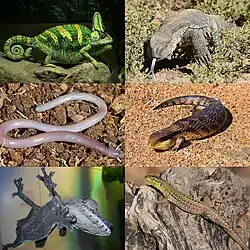 Clockwise from top left: veiled chameleon (Chamaeleo calyptratus), rock monitor (Varanus albigularis), common blue-tongued skink (Tiliqua scincoides), Italian wall lizard (Podarcis sicula), giant leaf-tailed gecko (Uroplatus fimbriatus), and legless lizard (Anelytropsis papillosus)
Clockwise from top left: veiled chameleon (Chamaeleo calyptratus), rock monitor (Varanus albigularis), common blue-tongued skink (Tiliqua scincoides), Italian wall lizard (Podarcis sicula), giant leaf-tailed gecko (Uroplatus fimbriatus), and legless lizard (Anelytropsis papillosus)
Lizard is the common name used for all squamate reptiles other than snakes (and to a lesser extent amphisbaenians), encompassing over 7,000 species, ranging across all continents except Antarctica, as well as most oceanic island chains. The grouping is paraphyletic as some lizards are more closely related to snakes than they are to other lizards. Lizards range in size from chameleons and geckos a few centimeters long to the 3-meter-long Komodo dragon. (Full article...) -
![Image 10 Yacare caiman, Caiman yacare A caiman (/ˈkeɪmən/ (also spelled cayman) from Taíno kaiman[additional citation(s) needed]) is an alligatorid belonging to the subfamily Caimaninae, one of two primary lineages within the Alligatoridae family, the other being alligators. Caimans are native to Central and South America and inhabit marshes, swamps, lakes, and mangrove rivers. They have scaly skin and live a fairly nocturnal existence. They are relatively small-sized crocodilians with an average maximum weight of 6 to 40 kg (13 to 88 lb) depending on species, with the exception of the black caiman (Melanosuchus niger), which can grow more than 4 m (13 ft) long and weigh more than 450 kg (990 lb). The black caiman is the largest caiman species in the world and is found in the slow-moving rivers and lakes that surround the Amazon basin. The smallest species is the Cuvier's dwarf caiman (Paleosuchus palpebrosus), which grows to 1.2 to 1.5 m (3.9 to 4.9 ft) long. There are six different species of caiman found throughout the watery jungle habitats of Central and Southern America. The average length for most of the other caiman species is about 2 to 2.5 m (6.6 to 8.2 ft) long. (Full article...)](./_assets_/Blank.png) Image 10
Image 10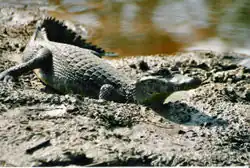 Yacare caiman, Caiman yacare
Yacare caiman, Caiman yacare
A caiman (/ˈkeɪmən/ (also spelled cayman) from Taíno kaiman) is an alligatorid belonging to the subfamily Caimaninae, one of two primary lineages within the Alligatoridae family, the other being alligators. Caimans are native to Central and South America and inhabit marshes, swamps, lakes, and mangrove rivers. They have scaly skin and live a fairly nocturnal existence. They are relatively small-sized crocodilians with an average maximum weight of 6 to 40 kg (13 to 88 lb) depending on species, with the exception of the black caiman (Melanosuchus niger), which can grow more than 4 m (13 ft) long and weigh more than 450 kg (990 lb). The black caiman is the largest caiman species in the world and is found in the slow-moving rivers and lakes that surround the Amazon basin. The smallest species is the Cuvier's dwarf caiman (Paleosuchus palpebrosus), which grows to 1.2 to 1.5 m (3.9 to 4.9 ft) long. There are six different species of caiman found throughout the watery jungle habitats of Central and Southern America. The average length for most of the other caiman species is about 2 to 2.5 m (6.6 to 8.2 ft) long. (Full article...)
Selected images
-
 Image 1Photograph: Steevven1The gold dust day gecko (Phelsuma laticauda) is a diurnal species of gecko. Endemic to northern Madagascar and the Comoros, it has been introduced to Hawaii and other Pacific islands. It typically inhabits trees and houses, and feeds on insects and nectar.
Image 1Photograph: Steevven1The gold dust day gecko (Phelsuma laticauda) is a diurnal species of gecko. Endemic to northern Madagascar and the Comoros, it has been introduced to Hawaii and other Pacific islands. It typically inhabits trees and houses, and feeds on insects and nectar. -
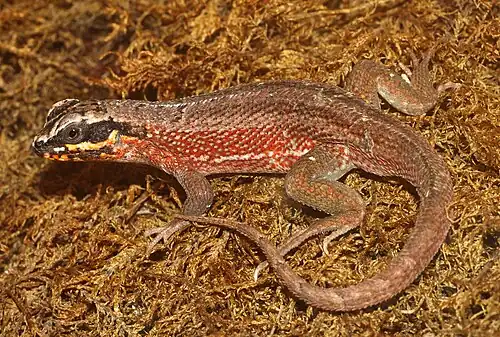 Image 2Leiocephalus personatus is a species of curly-tailed lizard first described by Edward Drinker Cope in 1862. This specimen was photographed in the reptile zoo of Neu-Ulm, Germany.
Image 2Leiocephalus personatus is a species of curly-tailed lizard first described by Edward Drinker Cope in 1862. This specimen was photographed in the reptile zoo of Neu-Ulm, Germany. -
 Image 3Photo credit: John O'NeillThe Eastern Bearded Dragon (Pogona barbata) is a lizard found in wooded parts of Australia. It is a large species of grey-black colour distinguished from its relative, the Central Bearded Dragon, by its less robust body and the row of spines along the lateral edge of the body, which continues over the forearm. It has an adult snout-tail length of about 60 cm (24 in).
Image 3Photo credit: John O'NeillThe Eastern Bearded Dragon (Pogona barbata) is a lizard found in wooded parts of Australia. It is a large species of grey-black colour distinguished from its relative, the Central Bearded Dragon, by its less robust body and the row of spines along the lateral edge of the body, which continues over the forearm. It has an adult snout-tail length of about 60 cm (24 in). -
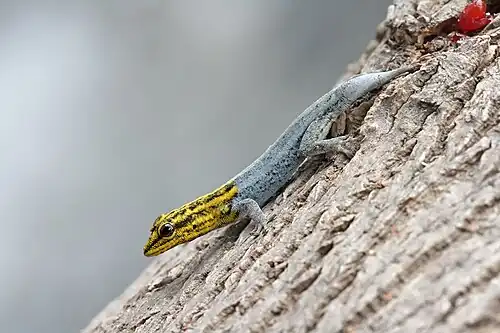 Image 4Photo: Muhammad Mahdi KarimThe dwarf yellow-headed gecko (Lygodactylus luteopicturatus) is a small gecko species native to the rocky areas of southern Kenya, eastern Tanzania, and Zanzibar. This individual's tail, which had been shed through autotomy, is regenerating.
Image 4Photo: Muhammad Mahdi KarimThe dwarf yellow-headed gecko (Lygodactylus luteopicturatus) is a small gecko species native to the rocky areas of southern Kenya, eastern Tanzania, and Zanzibar. This individual's tail, which had been shed through autotomy, is regenerating. -
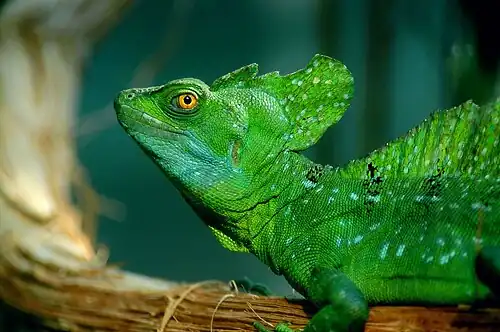 Image 5Photo credit: Marcel Burkhard (cele4)The Plumed Basilisk (Basiliscus plumifrons) is a species of lizard native to Latin America. Its natural range covers a swath from Mexico to Ecuador.
Image 5Photo credit: Marcel Burkhard (cele4)The Plumed Basilisk (Basiliscus plumifrons) is a species of lizard native to Latin America. Its natural range covers a swath from Mexico to Ecuador. -
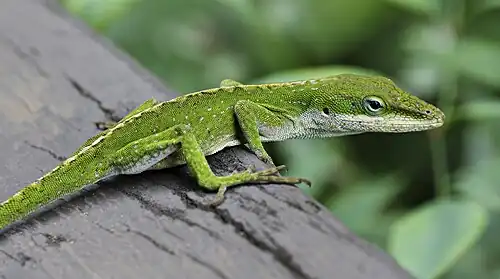 Image 6Photo credit: Paul HirstAn anole lizard of the family Polychrotidae found in Hilo, Hawaii, United States. Anoles are small and common lizards that can be found throughout the various regions of the Western Hemisphere. They are frequently and incorrectly called chameleons or geckos due to their ability to alter their skin color and run up walls, respectively.
Image 6Photo credit: Paul HirstAn anole lizard of the family Polychrotidae found in Hilo, Hawaii, United States. Anoles are small and common lizards that can be found throughout the various regions of the Western Hemisphere. They are frequently and incorrectly called chameleons or geckos due to their ability to alter their skin color and run up walls, respectively. -
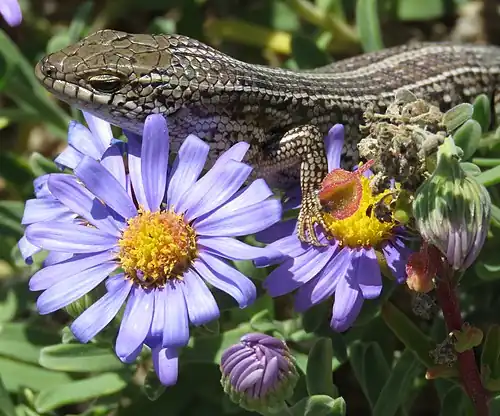
-
.jpg) Image 8Photograph credit: Augustus BinuPtyas mucosa, the Indian rat snake, is a common species of colubrid snake found in parts of southern and southeastern Asia. Growing to a length of 1.5 to 1.9 m (5 to 6 ft), they are very slender, diurnal and semi-arboreal. They inhabit forest floors, wetlands, rice paddies, and farmland, and are frequently found in urban areas where rodents thrive. They are harmless to humans, but are fast-moving and adept at catching the small mammals, birds, amphibians and other reptiles on which they feed, subduing their prey by lying on and suffocating them.
Image 8Photograph credit: Augustus BinuPtyas mucosa, the Indian rat snake, is a common species of colubrid snake found in parts of southern and southeastern Asia. Growing to a length of 1.5 to 1.9 m (5 to 6 ft), they are very slender, diurnal and semi-arboreal. They inhabit forest floors, wetlands, rice paddies, and farmland, and are frequently found in urban areas where rodents thrive. They are harmless to humans, but are fast-moving and adept at catching the small mammals, birds, amphibians and other reptiles on which they feed, subduing their prey by lying on and suffocating them. -
 Image 9Photo credit: Rich TorresChamaeleo jacksonii, commonly known as Jackson's Chameleon or the Three-horned Chameleon, is an African chameleon. Native to the humid, cooler regions of Kenya and Tanzania, this specimen is from a feral population established in Hawaii in the 1970s. Males possess three brown horns, but females usually have none or just traces of the rostral horn (on the nose).
Image 9Photo credit: Rich TorresChamaeleo jacksonii, commonly known as Jackson's Chameleon or the Three-horned Chameleon, is an African chameleon. Native to the humid, cooler regions of Kenya and Tanzania, this specimen is from a feral population established in Hawaii in the 1970s. Males possess three brown horns, but females usually have none or just traces of the rostral horn (on the nose). -
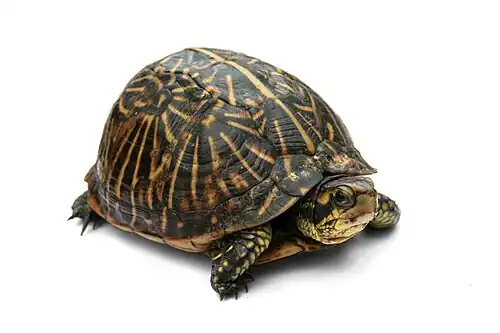 Image 10Photo credit: Jon ZanderThe Florida Box Turtle (Terrapene carolina bauri) is endemic to the U.S. state of Florida and the extreme southeastern portion of Georgia. It can be found in damp environments, such as wetlands, marshlands, and near swamps, but usually does not enter water deep enough to swim.
Image 10Photo credit: Jon ZanderThe Florida Box Turtle (Terrapene carolina bauri) is endemic to the U.S. state of Florida and the extreme southeastern portion of Georgia. It can be found in damp environments, such as wetlands, marshlands, and near swamps, but usually does not enter water deep enough to swim. -
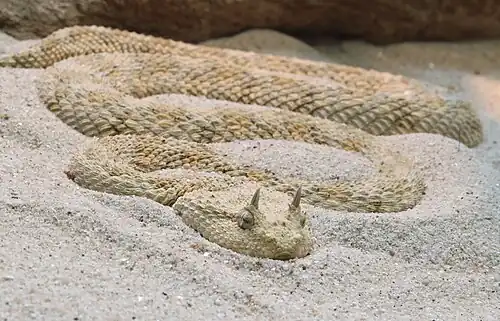 Image 11Cerastes cerastes, commonly known as the Saharan horned viper or the horned desert viper, is a venomous species of viper native to the deserts of northern Africa and parts of the Arabian Peninsula and Levant. It often is easily recognized by the presence of a pair of supraocular "horns", although hornless individuals do occur.
Image 11Cerastes cerastes, commonly known as the Saharan horned viper or the horned desert viper, is a venomous species of viper native to the deserts of northern Africa and parts of the Arabian Peninsula and Levant. It often is easily recognized by the presence of a pair of supraocular "horns", although hornless individuals do occur. -
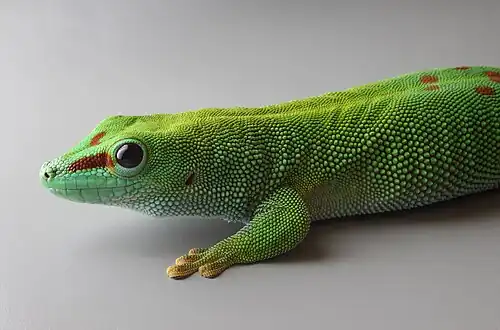 Image 12Photograph: H. KrispPhelsuma grandis is a species of day gecko that lives in Madagascar. Found in a wide range of habitats, it can measure up to 30 centimetres (12 in) in length.
Image 12Photograph: H. KrispPhelsuma grandis is a species of day gecko that lives in Madagascar. Found in a wide range of habitats, it can measure up to 30 centimetres (12 in) in length. -
Image 13Photo: Thierry CaroThe Gold dust day gecko (Phelsuma laticauda) is a diurnal species of day gecko native to Madagascar and the Comoros, although it has been introduced to Hawaii and other Pacific islands. It grows to about 15–22 cm (6–9 in) in length and is bright green or yellowish green with rufous bars on the snout and head, and red bars on the lower back.
-
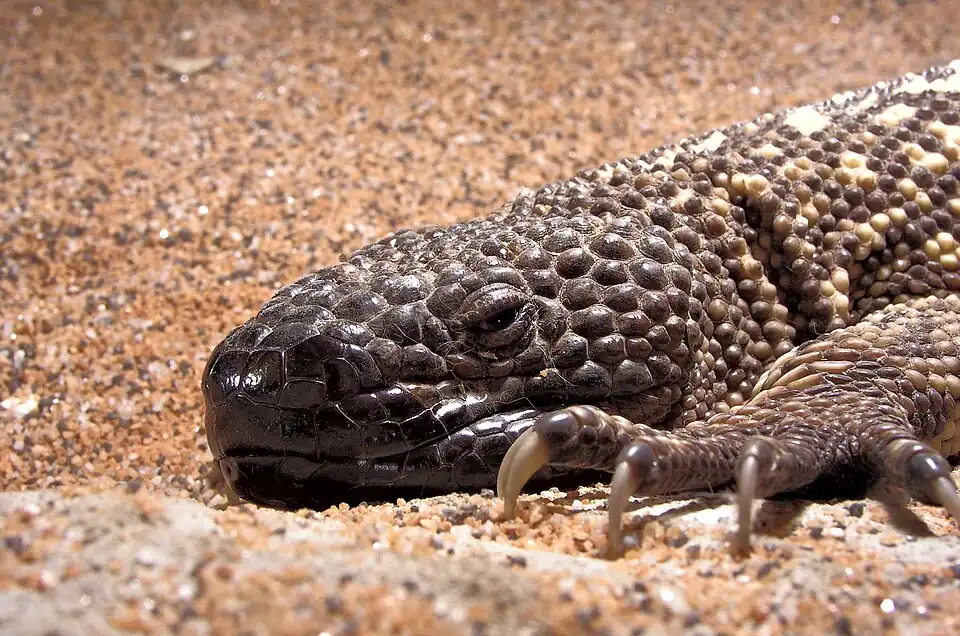 Image 14
Image 14 -
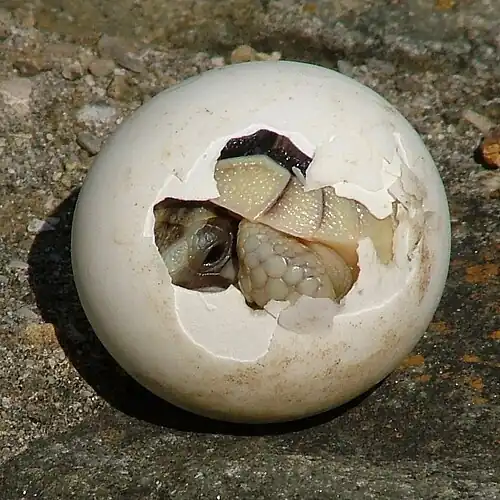
-
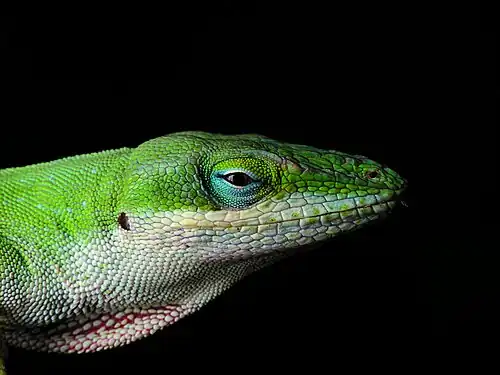 Image 16
Image 16 -
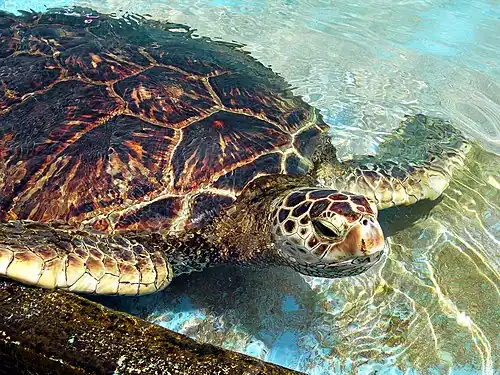 Image 17Green sea turtle
Image 17Green sea turtle -
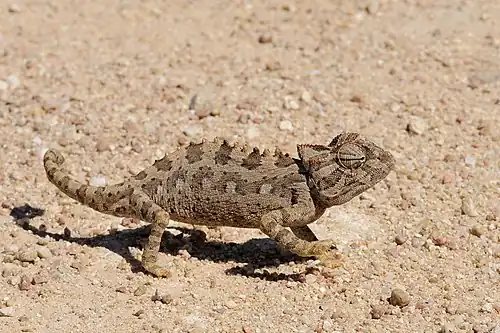 Image 18Photograph: Hans StieglitzThe Namaqua chameleon is a lizard found in the western desert regions of Namibia, South Africa, and southern Angola. This species, which can reach 25 centimetres (9.8 in) in length, is common in the Namib Desert. It has evolved several adaptations which allow it to thrive in hot and arid areas, such as the ability to change color to control temperature.
Image 18Photograph: Hans StieglitzThe Namaqua chameleon is a lizard found in the western desert regions of Namibia, South Africa, and southern Angola. This species, which can reach 25 centimetres (9.8 in) in length, is common in the Namib Desert. It has evolved several adaptations which allow it to thrive in hot and arid areas, such as the ability to change color to control temperature. -
 Image 19Photo: Tancrède Dumas; Restoration: Lise BroerA late nineteenth century photo of snake charmers in Tangier, Morocco. Snake charming is the practice of apparently hypnotising a snake, and the performance may use musical instruments and other street performance techniques. The practice as it exists today probably arose in India, where it remains widely practiced, and spread throughout Southeast Asia, the Middle East, and North Africa.
Image 19Photo: Tancrède Dumas; Restoration: Lise BroerA late nineteenth century photo of snake charmers in Tangier, Morocco. Snake charming is the practice of apparently hypnotising a snake, and the performance may use musical instruments and other street performance techniques. The practice as it exists today probably arose in India, where it remains widely practiced, and spread throughout Southeast Asia, the Middle East, and North Africa. -
Image 20Photo credit: Mila ZinkovaThe green turtle (Chelonia mydas) is a large sea turtle belonging to the family Cheloniidae. Despite the turtle's common name, it is lightly-colored all around while its carapace's hues range from olive-brown to black. The turtle is actually named for the greenish coloration of its fat and flesh.
-
_on_a_tree_trunk.jpg) Image 21Photograph credit: Basile MorinEutropis macularia, the bronze grass skink, is a species of lizard in the skink family, Scincidae, native to South and Southeast Asia. It lives in both deciduous and evergreen forests, in plantations, in grasslands, and in rocky areas with scattered trees. The species is active in both the day and the night, feeding on insects and other invertebrates. This bronze grass skink was photographed on a tree trunk on the island of Don Det in Laos.
Image 21Photograph credit: Basile MorinEutropis macularia, the bronze grass skink, is a species of lizard in the skink family, Scincidae, native to South and Southeast Asia. It lives in both deciduous and evergreen forests, in plantations, in grasslands, and in rocky areas with scattered trees. The species is active in both the day and the night, feeding on insects and other invertebrates. This bronze grass skink was photographed on a tree trunk on the island of Don Det in Laos. -
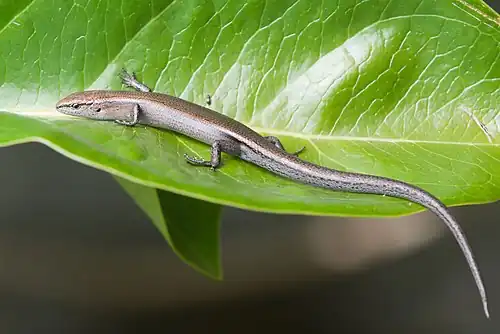 Image 22Photograph: JJ HarrisonNiveoscincus metallicus, commonly known as the metallic skink, is a species of skink in the family Scincidae. It is endemic to Australia, where it is found in southern Victoria, as well as in Tasmania and many offshore islands in Bass Strait.
Image 22Photograph: JJ HarrisonNiveoscincus metallicus, commonly known as the metallic skink, is a species of skink in the family Scincidae. It is endemic to Australia, where it is found in southern Victoria, as well as in Tasmania and many offshore islands in Bass Strait. -

-
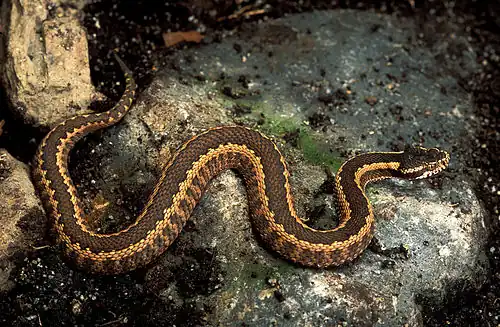 Image 24Photograph: Benny TrappVipera dinniki is a species of venomous viper which can reach 48.6 cm (19.1 in) in length. First described by Alexander Nikolsky in 1913, V. dinniki is found in the highlands of Russia, Georgia, and Azerbaijan.
Image 24Photograph: Benny TrappVipera dinniki is a species of venomous viper which can reach 48.6 cm (19.1 in) in length. First described by Alexander Nikolsky in 1913, V. dinniki is found in the highlands of Russia, Georgia, and Azerbaijan. -
 Image 25Asian vine snake Ahaetulla prasina. This snake has a wide distribution in Asia. It feeds on small reptiles and amphibians, particularly lizards and tree frogs. Adults may attain 1.8 m (6 feet) in total length, with a tail 0.6 m (2 feet) long. Its appearance is very much like those of South American vine snakes. It is a rear-fanged species and is mildly venomous but is not considered a threat to humans.
Image 25Asian vine snake Ahaetulla prasina. This snake has a wide distribution in Asia. It feeds on small reptiles and amphibians, particularly lizards and tree frogs. Adults may attain 1.8 m (6 feet) in total length, with a tail 0.6 m (2 feet) long. Its appearance is very much like those of South American vine snakes. It is a rear-fanged species and is mildly venomous but is not considered a threat to humans.
Selected Crocodilia articles
-
 Image 1At Zapata Swamp, Matanzas Province, Cuba
Image 1At Zapata Swamp, Matanzas Province, Cuba
The Cuban crocodile (Crocodylus rhombifer) is a small-medium species of crocodile endemic to Cuba. Typical length is 2.1–2.3 m (6 ft 11 in – 7 ft 7 in) and typical weight 70–80 kg (150–180 lb). Large males can reach as much as 3.5 m (11 ft) in length and weigh more than 215 kg (474 lb).
The Cuban crocodile is of interest to biologists for its unique physical and behavioral traits. Long- and strong-legged, it is the most terrestrial of extant crocodiles. Its preferred habitat comprises freshwater and brackish water environments, such as mangrove swamps, coastal lagoons, estuaries, marshes, floodplains, and river deltas. There, the adults feed on fish, turtles and small mammals, while the young eat invertebrates and smaller fish. Mating occurs between May and July. Captive animals have displayed cooperative hunting behavior, and can be taught tricks, suggesting intelligence. (Full article...) -
 Image 2
Image 2.jpg)
The black caiman (Melanosuchus niger) is a crocodilian reptile endemic to South America. With a maximum length of around 5 to 6.5 m (16 to 21 ft) and a mass of over 450 kg (1,000 lb), it is the largest living species of the family Alligatoridae, and the third-largest crocodilian in the Neotropical realm. True to its common and scientific names, the black caiman has a dark greenish-black coloration as an adult. In some individuals, the pigmentation can appear almost jet-black. It has grey to brown banding on the lower jaw; juveniles have a more vibrant coloration compared to adults, with prominent white-pale yellow banding on the flanks that remains present well into adulthood (more than most other species). The banding on young helps with camouflage by breaking up their body outline, on land or in water, in an effort to avoid predation. The morphology is quite different from other caimans but the bony ridge that occurs in other caimans is present. The head is large and heavy, an advantage in catching larger prey. Like all crocodilians, caimans are long, squat creatures, with big jaws, long tails and short legs. They have thick, scaled skin, and their eyes and noses are located on the tops of their heads. This enables them to see and breathe while the rest of their bodies are underwater.
A carnivorous animal, the black caiman lives along freshwater habitats, including slow-moving rivers, lakes and seasonally flooded savannas, where it preys upon a variety of fish, reptiles, birds, and mammals. Being an apex predator and potentially a keystone species, it is generalist, capable of taking most animals within its range, and might have played a critical role in maintaining the structure of the ecosystem. Although only a mere few specific ecological studies have been conducted, it is observed that this species has its own niche which allows coexistence with other competitors. (Full article...) -
 Image 3
Image 3_Gal_Oya.jpg)
The mugger crocodile (Crocodylus palustris) is a medium-sized broad-snouted crocodile, also known as mugger and marsh crocodile. It is native to freshwater habitats from south-eastern Iran to the Indian subcontinent, where it inhabits marshes, lakes, rivers and artificial ponds. It rarely reaches a body length of 5 m (16 ft 5 in) and is a powerful swimmer, but also walks on land in search of suitable waterbodies during the hot season. Both young and adult mugger crocodiles dig burrows to which they retreat when the ambient temperature drops below 5 °C (41 °F) or exceeds 38 °C (100 °F). Females dig holes in the sand as nesting sites and lay up to 46 eggs during the dry season. The sex of hatchlings depends on temperature during incubation. Both parents protect the young for up to one year. They feed on insects, and adults prey on fish, reptiles, birds and mammals.
The mugger crocodile evolved at least 4.19 million years ago and has been a symbol for the fructifying and destructive powers of the rivers since the Vedic period. It was first scientifically described in 1831 and is protected by law in Iran, India and Sri Lanka. Since 1982, it has been listed as Vulnerable on the IUCN Red List. Outside protected areas, it is threatened by conversion of natural habitats, gets entangled in fishing nets and is killed in human–wildlife conflict situations and in traffic accidents. (Full article...) -
 Image 4
Image 4 Siamese crocodile at Moscow Zoo
Siamese crocodile at Moscow Zoo
The Siamese crocodile (Crocodylus siamensis) is a medium-sized freshwater crocodile native to Indonesia (East Kalimantan and possibly other areas historically), Laos, Cambodia, Thailand and Vietnam. Historical records from Myanmar remain unverified. The species is critically endangered and already extirpated from many regions. Its other common names include Siamese freshwater crocodile, Singapore small-grain, and soft-belly. (Full article...) -
 Image 5
Image 5
Cuvier's dwarf caiman (Paleosuchus palpebrosus) is a small crocodilian in the alligator family from northern and central South America. It is found in Bolivia, Brazil, Colombia, Ecuador, French Guiana, Guyana, Paraguay, Peru, Suriname, Trinidad and Venezuela. It lives in riverine forests, flooded forests near lakes, and near fast-flowing rivers and streams. It can traverse dry land to reach temporary pools and tolerates colder water than other species of caimans. Other common names for this species include the musky caiman, the dwarf caiman, Cuvier's caiman, and the smooth-fronted caiman (the latter name is also used for P. trigonatus). It is sometimes kept in captivity as a pet and may be referred to as the wedge-head caiman by the pet trade community.
Cuvier's dwarf caiman was first described by the French zoologist Georges Cuvier in 1807 and is one of only two species in the genus Paleosuchus, the other species being P. trigonatus. Their closest relatives are the other caimans in the subfamily Caimaninae. With a total length averaging 1.4 m (4.6 ft) for males and up to 1.2 m (3.9 ft) for females, Cuvier's dwarf caiman is not only the smallest extant species in the alligator and caiman family, but also the smallest of all crocodilians (unless the Congo dwarf crocodile is considered a valid species). An adult weighs around 5 to 7 kg (11 to 15 lb). Its lack of size is partly made up for by its strong body armor, provided by the bony bases to its dermal scales, which provides protection against predators. Juvenile dwarf caimans mainly feed on invertebrates, but also small fish and frogs, while adults eat larger fish, amphibians, and invertebrates, such as large molluscs. This caiman sometimes uses a burrow as shelter during the day and in the Pantanal may aestivate in the burrow to stay cool in the dry season. The female buries her eggs on a mounded nest and these take about 3 months to hatch. She helps the hatchlings to escape from the nest and provides some parental care for the first few weeks of their lives. This caiman has a wide range and large total population and the IUCN lists its conservation status as being of least concern. (Full article...) -
 Image 6
Image 6
Mecistops is a genus of crocodiles, the slender-snouted crocodiles, native to sub-Saharan Africa. (Full article...) -
 Image 7
Image 7.jpg) A smooth-fronted caiman at Zoologischer Garten Berlin in Berlin, Germany
A smooth-fronted caiman at Zoologischer Garten Berlin in Berlin, Germany
The smooth-fronted caiman (Paleosuchus trigonatus), also known as Schneider's dwarf caiman or Schneider's smooth-fronted caiman, is a crocodilian from South America, where it is native to the Amazon and Orinoco Basins. It is the second-smallest species of the family Alligatoridae, the smallest being Cuvier's dwarf caiman, also from tropical South America and in the same genus. An adult typically grows to around 1.2 to 1.6 m (3.9 to 5.2 ft) in length and weighs between 9 and 20 kg (20 and 44 lb). Exceptionally large males can reach as much as 2.3 m (7.5 ft) in length and 36 kg (79 lb) in weight. (Full article...) -
 Image 8
Image 8_male.jpg) Male gharial
Male gharial
The gharial (Gavialis gangeticus), also known as gavial or fish-eating crocodile, is a crocodilian in the family Gavialidae and among the longest of all living crocodilians. Mature females are 2.6 to 4.5 m (8 ft 6 in to 14 ft 9 in) long, and males 3 to 6 m (9 ft 10 in to 19 ft 8 in). Adult males have a distinct boss at the end of the snout, which resembles an earthenware pot known as a ghara, hence the name "gharial". The gharial is well adapted to catching fish because of its long, narrow snout and 110 sharp, interlocking teeth.
The gharial probably evolved in the northern Indian subcontinent. Fossil gharial remains were excavated in Pliocene deposits in the Sivalik Hills and the Narmada River valley. It currently inhabits rivers in the plains of the northern part of the Indian subcontinent. It is the most thoroughly aquatic crocodilian, and leaves the water only for basking and building nests on moist sandbanks. Adults mate at the end of the cold season. Females congregate in spring to dig nests, in which they lay 20–95 eggs. They guard the nests and the young, which hatch before the onset of the monsoon. The hatchlings stay and forage in shallow water during their first year, but move to sites with deeper water as they grow. (Full article...) -
 Image 9
Image 9_-_Flickr_-_berniedup.jpg) Mato Grosso, Brazil
Mato Grosso, Brazil
The yacare caiman (Caiman yacare), also known commonly as the jacare caiman, Paraguayan caiman, piranha caiman, red caiman, and southern spectacled caiman, is a species of caiman, a crocodilian in the family Alligatoridae. The species is endemic to Argentina, Bolivia, Brazil, and Paraguay. Brown in color and covered with dark blotches, males grow to a total length (including tail) of 2–3 m (6 ft 7 in – 9 ft 10 in) and weigh around 40–50 kg (88–110 lb); while females grow to 1.4 m (4 ft 7 in) long and about 15–20 kg (33–44 lb). Typical habitats of this caiman include lakes, rivers, and wetlands. Its diet primarily consists of aquatic animals, such as snails, and occasionally land vertebrates. Mating occurs in the rainy season and eggs hatch in March, with young fending for themselves as soon as they hatch. The yacare caiman was hunted heavily for its skin to use for leather in the 1980s, which caused its population to decrease significantly. However, trading restrictions placed since have caused its population to increase. Its population in the Pantanal is about 10 million, and it is listed as least concern on the IUCN Red List. (Full article...) -
 Image 10
Image 10 An adult basking on the island of Palawan, Philippines
An adult basking on the island of Palawan, Philippines
The Philippine crocodile (Crocodylus mindorensis), also known as the Mindoro crocodile, the Philippine freshwater crocodile, the bukarot in Ilocano, and more generally as a buwaya in most Filipino lowland cultures, is one of two species of crocodiles found in the Philippines; the other is the larger saltwater crocodile (Crocodylus porosus). The Philippine crocodile, the species endemic only to the country, went from data deficient to critically endangered in 2008 from exploitation and unsustainable fishing methods, such as dynamite fishing. Conservation methods are being taken by the Dutch/Filipino Mabuwaya foundation, the Crocodile Conservation Society and the Zoological Institute of HerpaWorld in Mindoro island. It is strictly prohibited to kill a crocodile in the country, and it is punishable by law. (Full article...) -
 Image 11
Image 11 At the Columbus Zoo and Aquarium in Powell, Ohio
At the Columbus Zoo and Aquarium in Powell, Ohio
The American alligator (Alligator mississippiensis), sometimes referred to as a common alligator or simply gator, is a large crocodilian reptile native to the Southeastern United States. It is one of the two extant species in the genus Alligator, and is larger than the only other living alligator species, the Chinese alligator.
Adult male American alligators measure 3.4 to 4.5 m (11.2 to 14.8 ft) in length, and can weigh up to 500 kg (1,100 lb), with unverified sizes of up to 5.84 m (19.2 ft) and weights of 1,000 kg (2,200 lb) making it the second longest and the heaviest of the family Alligatoridae, after the black caiman. Females are smaller, measuring 2.6 to 3 m (8.5 to 9.8 ft) in length. The American alligator inhabits subtropical and tropical freshwater wetlands, such as marshes and cypress swamps, from southern Texas to North Carolina. It is distinguished from the sympatric American crocodile by its broader snout, with overlapping jaws and darker coloration, and is less tolerant of saltwater but more tolerant of cooler climates than the American crocodile, which is found only in tropical and warm subtropical climates. (Full article...) -
 Image 12New Guinea crocodile at Bandung Zoo in West Java, Indonesia
Image 12New Guinea crocodile at Bandung Zoo in West Java, Indonesia
The New Guinea crocodile (Crocodylus novaeguineae) is a small species of crocodile found on the island of New Guinea north of the mountain ridge that runs along the centre of the island. The population found south of the mountain ridge, formerly considered a genetically distinct population, is now considered a distinct species, Hall's New Guinea crocodile (C. halli). In the past it included the Philippine crocodile, C. n. mindorensis, as a subspecies, but today they are regarded as separate species. The habitat of the New Guinea crocodile is mostly freshwater swamps and lakes. It is most active at night when it feeds on fish and a range of other small animals. A female crocodile lays a clutch of eggs in a nest composed of vegetation and she lies up nearby to guard the nest. There is some degree of parental care for newly hatched juveniles. This crocodile was over-hunted for its valuable skin in the mid 20th century, but conservation measures have since been put in place, it is reared in ranches and the International Union for Conservation of Nature (IUCN) lists it as being of "Least Concern". (Full article...) -
 Image 13
Image 13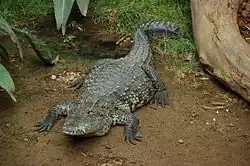
Morelet's crocodile (Crocodylus moreletii), also known as the Mexican crocodile or Belize crocodile, is a modest-sized crocodilian found only in the Atlantic regions of Mexico, Belize and Guatemala. It usually grows to about 3 metres (10 ft) in length. It is a species at least concern for extinction according to the International Union for Conservation of Nature.
The species has a fossil record in Guatemala. (Full article...) -
 Image 14
Image 14
The dwarf crocodile (Osteolaemus tetraspis), also known as the African dwarf crocodile, broad-snouted crocodile (a name more often used for the Asian mugger crocodile) or bony crocodile, is an African crocodile that is also the smallest extant (living) species of crocodile. (Full article...) -
 Image 15
Image 15
The freshwater crocodile (Crocodylus johnstoni), also known commonly as the Australian freshwater crocodile, Johnstone's crocodile, and the freshie, is a species of crocodile native to the northern regions of Australia. Unlike its much larger Australian relative, the saltwater crocodile, the freshwater crocodile is not known as a man-eater, although it bites in self-defence, and brief, nonfatal attacks have occurred, apparently the result of mistaken identity. (Full article...) -
 Image 16
Image 16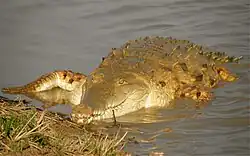 Orinoco crocodile in Los Llanos, Venezuela
Orinoco crocodile in Los Llanos, Venezuela
The Orinoco crocodile (Crocodylus intermedius) is a critically endangered crocodile. Its population is very small, and they can only be found in the Orinoco river basin in Venezuela and Colombia. Extensively hunted for their skins in the 19th and 20th centuries, it is one of the most endangered species of crocodiles. It is a very large species of crocodilian; males have been reported up to 6.8 m (22 ft 4 in) in the past, weighing over 900 kg (2,000 lb), but such sizes do not exist today, 5.2 m (17 ft 1 in) being a more widely accepted maximum size. A large male today may attain 4.2 m (13 ft 9 in) in length and can weigh up to 450 kg (1,000 lb), while females are substantially smaller with the largest likely to weigh around 225 kg (496 lb). Sexual dimorphism is not as profound as in other crocodilian species. The coloration is light even in adults.
The ecology of the Orinoco crocodile is poorly documented in the wild, mostly due to its small population. It is thought to have a more piscivorous diet with an opportunistic nature, resulting in generalist predatory behaviour. It is an apex predator and preys on a variety of birds, mammals and reptiles, including caimans on occasion. Its prey base is mostly large predatory fish, challenging the general view by locals complaining about crocodiles hunting local fish to very low numbers. Reproduction takes place in the dry season when the water level is low. It is a hole nester and digs holes in the sand for its clutch of eggs. The females guard the nests and young for several years. (Full article...) -
 Image 17In Llanos, Venezuela
Image 17In Llanos, Venezuela
The spectacled caiman (Caiman crocodilus), also known as the white caiman, common caiman, and speckled caiman, is a crocodilian in the family Alligatoridae. It is brownish-, greenish-, or yellowish-gray colored and has a spectacle-like ridge between its eyes, which is where its common name come from. It grows to a length of 1.4–2.5 m (4 ft 7 in – 8 ft 2 in) and a weight of 7–40 kg (15–88 lb), with males being both longer and heavier than females. Its diet varies seasonally, commonly consisting of crabs, fish, small mammals, amphibians and snails. Breeding occurs from May to August and 14–40 eggs are laid in July and August. This crocodilian has a large range and population; it is native to much of Latin America, and has been introduced to the United States, Cuba, and Puerto Rico. (Full article...) -
 Image 18
Image 18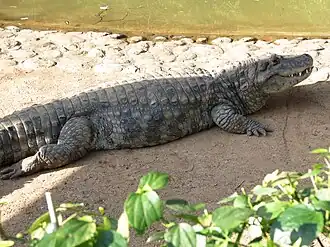 At São Paulo Zoo, Brazil
At São Paulo Zoo, Brazil
The broad-snouted caiman (Caiman latirostris) is a crocodilian in the family Alligatoridae found in eastern and central South America, including the Pantanal habitat of Bolivia, Southeast Brazil, and Paraguay, as well as northern Argentina and Uruguay. Behind the black caiman (Melanosuchus niger), it is the second-largest caiman species; it is the third-largest alligatorid behind the American alligator (Alligator mississippiensis) and the aforementioned black caiman. Primarily, the species inhabits freshwater wetlands, including floodplains, marshes, swamps, and some mangrove forests, as well as various streams, rivers, lakes or ponds, preferring bodies of rather still or slower-moving water. They will often utilize man-made cow ponds, disused stock tanks, and canals and ditches, as well. (Full article...) -
 Image 19At the Cincinnati Zoo
Image 19At the Cincinnati Zoo
The Chinese alligator (Alligator sinensis; simplified Chinese: 鼍; traditional Chinese: 鼉; pinyin: tuó), also known as the Yangtze alligator (simplified Chinese: 扬子鳄; traditional Chinese: 揚子鱷; pinyin: yángzǐ'è), China alligator, or historically the muddy dragon, is a crocodilian endemic to China. It and the American alligator (A. mississippiensis) are the only living species in the genus Alligator of the family Alligatoridae. Dark gray or black in color with a fully armored body, the Chinese alligator grows to 1.5–2.1 metres (5–7 ft) in length and weighs 36–45 kilograms (80–100 lb) as an adult. It brumates in burrows in winter and is nocturnal in summer. Mating occurs in early summer, with females most commonly producing 20–30 eggs, which are smaller than those of any other crocodilian. The species is an opportunistic feeder, primarily eating fish and invertebrates. A vocal species, adults bellow during the mating season and young vocalize to communicate with their parents and other juveniles. Captive specimens have reached age 70, and wild specimens can live past 50.
Living in bodies of fresh water, the Chinese alligator's range is restricted to six regions in the province of Anhui, as well as possibly the provinces of Jiangsu and Zhejiang. Originally living as far away from its current range as Japan, the species previously had a wide range and population, but beginning in 6000 BC, multiple threats, such as habitat destruction, caused the species' population and range to decline. The population in the wild was about 1,000 in the 1970s, decreased to below 130 in 2001, and grew after 2003, with its population being about 300 as of 2017. Listed as critically endangered by the International Union for Conservation of Nature, multiple conservation actions have been taking place for this species. (Full article...) -
 Image 20
Image 20.jpg) Male
Male
The saltwater crocodile (Crocodylus porosus) is a crocodilian native to saltwater habitats, brackish wetlands and freshwater rivers from India's east coast across Southeast Asia and the Sundaland to northern Australia and Micronesia. It has been listed as Least Concern on the IUCN Red List since 1996. It was hunted for its skin throughout its range up to the 1970s, and is threatened by illegal killing and habitat loss. It is regarded as dangerous to humans.
The saltwater crocodile is the largest living reptile. Males can grow up to a weight of 1,000–1,500 kg (2,200–3,300 lb) and a length of 6 m (20 ft), rarely exceeding 6.3 m (21 ft). Females are much smaller and rarely surpass 3 m (9.8 ft). It is also called the estuarine crocodile, Indo-Pacific crocodile, marine crocodile, sea crocodile, and, informally, the saltie. A large and opportunistic hypercarnivorous apex predator, they ambush most of their prey and then drown or swallow it whole. They will prey on almost any animal that enters their territory, including other predators such as sharks, varieties of freshwater and saltwater fish including pelagic species, invertebrates such as crustaceans, various amphibians, other reptiles, birds, and mammals. (Full article...) -
 Image 21
Image 21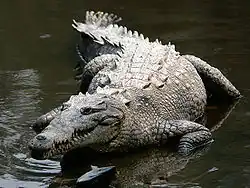 At La Manzanilla, Jalisco, Mexico
At La Manzanilla, Jalisco, Mexico
The American crocodile (Crocodylus acutus) is a species of crocodilian found in the Neotropics. It is the most widespread of the four extant species of crocodiles from the Americas, with populations present from South Florida, the Caribbean islands of Cuba, Jamaica, and Hispaniola, and the coasts of Mexico to as far south as Peru, Ecuador, Colombia, and Venezuela.
The habitat of the American crocodile consists largely of coastal areas. It is also found in river systems, but tends to prefer salinity, resulting in the species congregating in brackish lakes, mangrove swamps, lagoons, cays, and small islands. Other crocodiles also have tolerance to saltwater due to salt glands underneath the tongue, but the American crocodile is the only species other than the saltwater crocodile to commonly live and thrive in saltwater. They can be found on beaches and small island formations without any freshwater source, such as many cays and islets across the Caribbean. They are also found in hypersaline lakes; one of the largest known populations inhabits Lago Enriquillo in the Dominican Republic. (Full article...) -
 Image 22
Image 22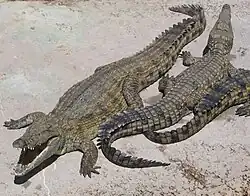 At Le Bonheur Crocodile Farm near Stellenbosch, South Africa
At Le Bonheur Crocodile Farm near Stellenbosch, South Africa
The Nile crocodile (Crocodylus niloticus) is a large crocodilian native to freshwater habitats in Africa, where it is present in 26 countries. It is widely distributed in sub-Saharan Africa, occurring mostly in the eastern, southern, and central regions of the continent, and lives in different types of aquatic environments such as lakes, rivers, swamps and marshlands. It occasionally inhabits deltas, brackish lakes and rarely also saltwater. Its range once stretched from the Nile Delta throughout the Nile River. Lake Turkana in Kenya has one of the largest undisturbed Nile crocodile populations.
Generally, the adult male Nile crocodile is between 3.5 and 5 m (11 ft 6 in and 16 ft 5 in) in length and weighs 225 to 750 kg (496 to 1,653 lb). However, specimens exceeding 6.1 m (20 ft) in length and 1,000 kg (2,200 lb) in weight have been recorded. It is the largest predator in Africa, and may be considered the second-largest extant reptile in the world, after the saltwater crocodile (Crocodylus porosus). Size is sexually dimorphic, with females usually about 30% smaller than males. The crocodile has thick, scaly, heavily armoured skin. (Full article...) -
 Image 23West African crocodile in Bazoulé, Burkina Faso
Image 23West African crocodile in Bazoulé, Burkina Faso
The West African crocodile, desert crocodile, or sacred crocodile (Crocodylus suchus) is a species of crocodile related to, and often confused with, the larger Nile crocodile (C. niloticus). (Full article...)
Selected snake articles
-
 Image 1
Image 1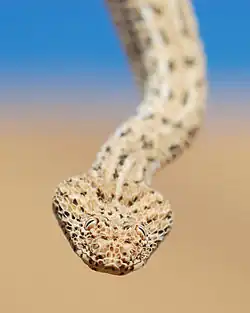
Bitis peringueyi, also known as the Peringuey's adder, Peringuey's desert adder or desert sidewinding adder, is a viper species found in Namibia and southern Angola. No subspecies are currently recognized. (Full article...) -
 Image 2
Image 2
The ball python (Python regius), also called the royal python, is a python species native to West and Central Africa, where it lives in grasslands, shrublands and open forests. This nonvenomous constrictor is the smallest of the African pythons, growing to a maximum length of 182 cm (72 in). The name "ball python" refers to its tendency to curl into a ball when stressed or frightened. (Full article...) -
 Image 3
Image 3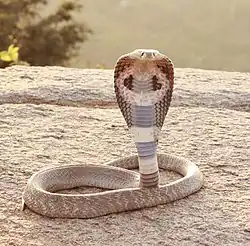
The Indian cobra (Naja naja /nadʒa nadʒa/), also known commonly as the spectacled cobra, Asian cobra, or binocellate cobra, is a species of cobra, a venomous snake in the family Elapidae. The species is native to the Indian subcontinent, and is a member of the "big four" species that are responsible for the most snakebite cases in Sri Lanka and India. (Full article...) -
 Image 4
Image 4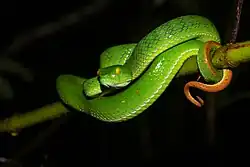 Trimeresurus macrops - Khao Yai National Park, Thailand
Trimeresurus macrops - Khao Yai National Park, Thailand
Trimeresurus macrops is a venomous pit viper species endemic to Southeast Asia. No subspecies are currently recognized. Common names include large-eyed pitviper, green pit viper, and Kramer's pit viper. (Full article...) -
 Image 5
Image 5.jpg)
The olive python (Liasis olivaceus) is a species of snake in the family Pythonidae. The species is endemic to Australia. Two subspecies are recognized, including the nominate subspecies described here. (Full article...) -
 Image 6
Image 6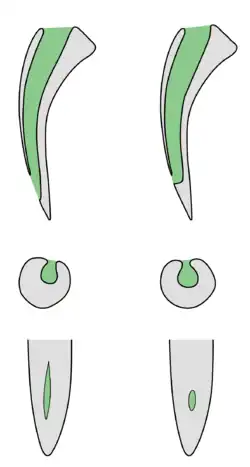
Schematic comparison between sections of non-spitting cobra fangs (left) and spitting (right).
1: Section of the whole fang in the sagittal plane.
2: Horizontal section through the fang at the discharge orifice.
3: Frontal view of the discharge orifices.
The term "spitting cobra" is commonly used to refer to several species of cobra that can intentionally, defensively shoot their venom directly from their fangs. This substance has two functions, with the first being as venom that can be absorbed via the victim’s eyes, mouth, or nose (or any mucous membrane or existing wound), and secondly as a toxungen, which can be sprayed on the target surface. Their ability to target and shoot venom is utilised in several different ways, self-defense being the most common instance. Studies have shown that the targets (at which the cobras shoot) are far from random; rather, spitting cobras consciously take aim, directing their spray to the eyes and face of an aggressor with 90% accuracy. In a remarkable case of convergent evolution, the individual cobra species evolved the ability to spit venom independently. (Full article...) -
 Image 7
Image 7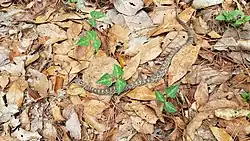
Crotalus intermedius gloydi is a subspecies of venomous pitviper in the family Viperidae. The subspecies is endemic to Mexico in the states of Oaxaca and Puebla. (Full article...) -
 Image 8
Image 8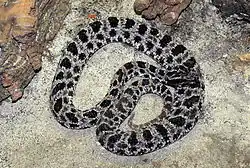
Sistrurus miliarius barbouri is a venomous pit viper subspecies endemic to the southeastern United States. (Full article...) -
 Image 9
Image 9 -
 Image 10
Image 10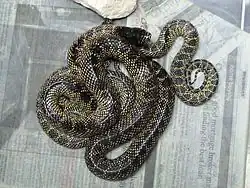 Pair of desert kingsnakes, Lampropeltis splendida
Pair of desert kingsnakes, Lampropeltis splendida
The desert kingsnake (Lampropeltis splendida) is a species of kingsnake native to Texas, Arizona, and New Mexico, United States. It is not venomous, colored yellow and black. The desert kingsnake's diet consists of rodents, lizards, and smaller snakes, including rattlesnakes. They normally grow 3–4 ft long, but have been known to grow up to 6.8 ft. They are docile creatures when confronted by humans. If they do not try to escape, often they "play dead" by flipping over onto their backs and lying motionless. Some who domesticate kingsnakes, such as ranchers, do so in the hopes that the kingsnakes will feed on other snakes, which might present more of a threat. It was previously considered a subspecies of the common kingsnake. The desert kingsnake belongs to the Colubridae family, which is the largest family of snakes in the world. (Full article...) -
 Image 11
Image 11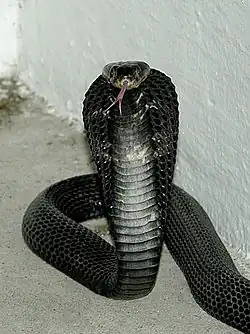
The Equatorial spitting cobra (Naja sumatrana) also called the Malayan spitting cobra, golden spitting cobra, Sumatran spitting cobra, or Palawan spitting cobra, is a species of spitting cobra found in Southeast Asia. (Full article...) -
 Image 12
Image 12_Photographed_By_Shantanu_Kuveskar.jpg)
Echis (common names: saw-scaled vipers, carpet vipers) is a genus of vipers found in the dry regions of Africa, the Middle East, India, Sri Lanka and Pakistan. They have a characteristic threat display, rubbing sections of their body together to produce a "sizzling" warning sound. The name Echis is the Latin transliteration of the Greek word for "viper" (ἔχις). Like all vipers, they are venomous. Their common name is "saw-scaled vipers" and they include some of the species responsible for causing the most snakebite cases and deaths in the world. Twelve species are currently recognized. (Full article...) -
 Image 13
Image 13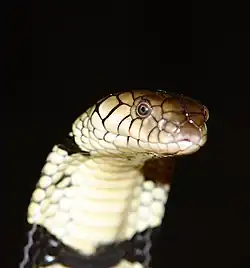
Naja annulata (formerly Boulengerina annulata), commonly known as the banded water cobra or the ringed water cobra, is a species of water cobra native to western and central Africa. (Full article...) -
 Image 14
Image 14_2.jpg) Specimen from the Prague Zoo
Specimen from the Prague Zoo
The rufous beaked snake (Rhamphiophis oxyrhynchus) is a species of mildly venomous snake in the family Psammophiidae. The species is native to East Africa. Its common name refers to its hooked snout, which it uses to dig burrows, and to its reddish-brown dorsal coloration. It hunts small animals during the day with the help of its venomous bite. (Full article...) -
 Image 15
Image 15_(7629832256).jpg)
Sanzinia madagascariensis, also known as the Madagascar tree boa or Malagasy tree boa, is a boa species endemic to the island of Madagascar. It was once considered conspecific with the Nosy Komba ground boa (Sanzinia volontany). Like all other boas, it is non-venomous. (Full article...) -
 Image 16
Image 16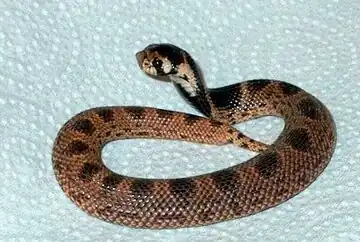 Aspidelaps scutatus, juvenile
Aspidelaps scutatus, juvenile
The shield-nosed cobra (Aspidelaps scutatus), also known commonly as the eastern shield-nose snake, is a species of venomous snake of the family Elapidae. The species is native to southern Africa. There are three recognized subspecies. (Full article...) -
 Image 17
Image 17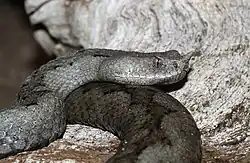
Vipera ammodytes, commonly known as horned viper, long-nosed viper, nose-horned viper, and sand viper, is a species of viper found in northern Italy, the Balkans, and parts of Asia Minor. Like all other vipers, it is venomous. It is reputed to be the most dangerous of the European vipers due to its large size, long fangs (up to 13 mm) and high venom toxicity. The specific name, ammodytes, is derived from the Greek words ammos, meaning "sand", and dutes, meaning "burrower" or "diver", despite its preference for rocky habitats. Five subspecies are currently recognized, including the nominate subspecies described here. (Full article...) -
 Image 18
Image 18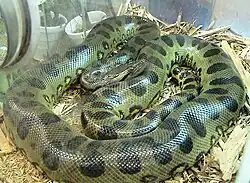 Green anaconda (E. murinus)
Green anaconda (E. murinus)
Anacondas or water boas are a group of large boas of the genus Eunectes. They are a semiaquatic group of snakes found in tropical South America. Three to five extant and one extinct species are currently recognized, including one of the largest snakes in the world, E. murinus, the green anaconda. (Full article...) -
 Image 19
Image 19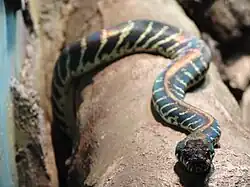
Simalia boeleni is a species of python, a nonvenomous snake in the family Pythonidae. The species is endemic to the mountains of New Guinea. No subspecies are recognized. Its common names include Boelen's python and the black python. (Full article...) -
 Image 20
Image 20_-_Flickr_-_2ndPeter.jpg) A timber rattlesnake in situ
A timber rattlesnake in situ
The timber rattlesnake (Crotalus horridus), also known commonly as the canebrake rattlesnake and the banded rattlesnake, is a species of pit viper in the family Viperidae. The species is native to the eastern United States. Like all other pit vipers, it is venomous, with a very toxic bite. Its venom is extremely potent, and both hemorrhagic and neurotoxic venom are present depending on population and location. C. horridus is the only rattlesnake species in most of the populous Northeastern United States and is second only to its relatives to the west, the prairie rattlesnake, as the most northerly distributed venomous snake in North America. There are no subspecies that are recognized as being valid. (Full article...) -
 Image 21
Image 21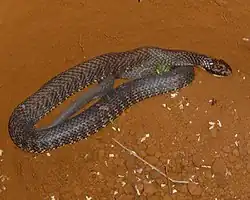 Notechis scutatus
Notechis scutatus
The tiger snake (Notechis scutatus) is a large and highly venomous snake of southern Australia, including its coastal islands and Tasmania. These snakes are often observed and locally well known by their banding, black and yellow like a tiger, although the species can be highly variable in colouration and patterning. All populations are classified within the genus Notechis (Elapidae). Their diverse characteristics have been classified either as distinct species or by subspecies and regional variation. (Full article...) -
 Image 22
Image 22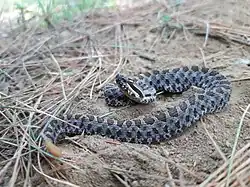 C. pusillus in Michoacán, Mexico
C. pusillus in Michoacán, Mexico
Crotalus pusillus, or the Tancitaran Dusky Rattlesnake, is a venomous pit viper species found in west-central Mexico. No subspecies are currently recognized. (Full article...) -
 Image 23
Image 23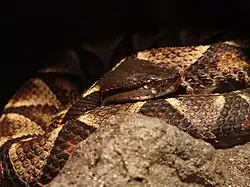
Deinagkistrodon is a monotypic genus created for the pit viper species, Deinagkistrodon acutus, which is endemic to Southeast Asia. No subspecies are currently recognized. (Full article...) -
 Image 24
Image 24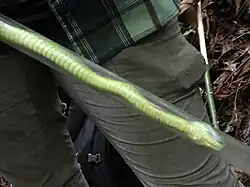
Bothriechis marchi, also known commonly as the Honduran palm pit viper and March's palm pit viper, is a species of pit viper, a venomous snake, in the subfamily Crotalinae of the family Viperidae. The species is native to Central America. There are no subspecies that are recognized as being valid. (Full article...) -
 Image 25
Image 25.jpg) Mozambique spitting cobra IUCN distributionExtant (resident)
Mozambique spitting cobra IUCN distributionExtant (resident)
The Mozambique spitting cobra (Naja mossambica) is a highly venomous species of spitting cobra in the family Elapidae. The species is native to Africa, and it is found in Angola, Botswana, Malawi, Mozambique, Namibia, South Africa, Tanzania, Zambia, and Zimbabwe. (Full article...)
Selected lizard articles
-
 Image 1
Image 1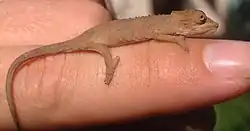
Setaro's dwarf chameleon (Bradypodion setaroi) is a species of lizard in the family Chamaeleonidae. (Full article...) -
 Image 2
Image 2 Draco indochinensis on a tree in Tân Phú district, Đồng Nai, Vietnam
Draco indochinensis on a tree in Tân Phú district, Đồng Nai, Vietnam
Draco indochinensis, also known as the Indochinese flying lizard or Indochinese gliding lizard, is a species of agamid lizard endemic to South-east Asia (Cambodia and southern Vietnam). (Full article...) -
 Image 3
Image 3
The northern Bahamian rock iguana (Cyclura cychlura) is a species of lizard of the genus Cyclura that is found on Andros Island and the Exuma islands in the Bahamas. Its status on the IUCN Red List is vulnerable, with a wild population of less than 5,000 animals. (Full article...) -
 Image 4
Image 4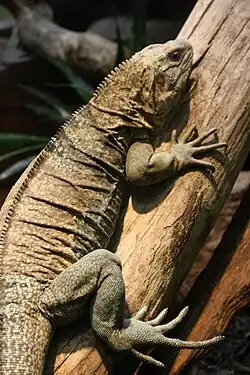
The Jamaican iguana (Cyclura collei), also known commonly as Colley's iguana, is a large species of lizard in the family Iguanidae. The species is endemic to Jamaica. It is critically endangered, even considered extinct between 1948 and 1990. Once found throughout Jamaica and on the offshore islets Great Goat Island and Little Goat Island, it is now confined to the forests of the Hellshire Hills. (Full article...) -
 Image 5
Image 5
Varanus spinulosus, the Solomon Island spiny monitor, Isabel monitor, or spiny-neck monitor, is a species of monitor lizard. It is endemic to the Solomon Islands archipelago and is also known from Santa Isabel Island, San Jorge Island (Solomon Islands) and Bourgainville Island (Papua New Guinea). (Full article...) -
 Image 6
Image 6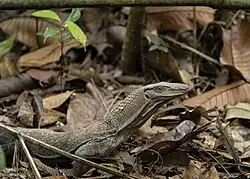
The black rough-necked monitor (Varanus rudicollis) is a species of monitor lizard found in Southeast Asian countries of Thailand, Burma, and Malaysia. It is also found in Indonesia on Sumatra and islands of the Riau Archipelago It is sometimes known simply as the roughneck monitor. In Thailand is called h̄èā cĥāng (Thai: เห่าช้าง; "elephant bark/roar"). (Full article...) -
 Image 7
Image 7
Draco spilonotus, the Sulawesi lined gliding lizard, is a lizard endemic to Sulawesi. The species is known from various localities in forested areas of Sulawesi. (Full article...) -
 Image 8
Image 8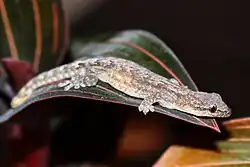
Lepidodactylus lugubris, known as the mourning gecko or common smooth-scaled gecko, is a species of lizard, a gecko of the family Gekkonidae. (Full article...) -
 Image 9
Image 9
The Indo-Pacific gecko (Hemidactylus garnotii), also known as Garnot's house gecko, fox gecko, or the Assam greyish-brown gecko, is a species of gecko native to South and Southeast Asia, Polynesia, and the east coast of Australia. (Full article...) -
 Image 10
Image 10.jpg) Draco maculatus in Thailand
Draco maculatus in Thailand
Draco maculatus, commonly known as the spotted flying dragon or spotted gliding lizard, is a species of agamid flying lizard endemic to Southeast Asia. It is capable of gliding from tree to tree. (Full article...) -
 Image 11
Image 11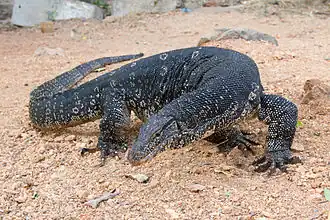 V. s. salvator
V. s. salvator
The Asian water monitor (Varanus salvator) is a large varanid lizard native to South and Southeast Asia. It is widely considered to be the second-largest lizard species, after the Komodo dragon. It is distributed from eastern and northeastern India and Bangladesh, the Andaman and Nicobar Islands, Sri Lanka, through southern China and Hainan Island in the east to mainland Southeast Asia and the islands of Sumatra, Borneo, Java, Lombok, the Riau Archipelago, and Sulawesi. It is one of the most widespread monitor lizards. (Full article...) -
 Image 12
Image 12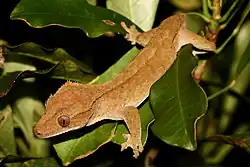
The crested gecko (Correlophus ciliatus), also known commonly as the eyelash gecko, is a species of lizard in the family Diplodactylidae. The species is native to southern New Caledonia. Originally described in 1866 by French zoologist Alphonse Guichenot, the species was thought to be extinct until it was rediscovered in 1994 during an expedition led by German herpetologist Robert Seipp. Along with several other New Caledonian gecko species, it is being considered for protected status by the Convention on the International Trade in Endangered Species of Wild Flora and Fauna. (Full article...) -
 Image 13
Image 13_male.jpg) moulting male
moulting male
The Cape dwarf chameleon (Bradypodion pumilum) is a chameleon native to the South African province of the Western Cape, where it is restricted to the region around Cape Town. (Full article...) -
 Image 14
Image 14_2.jpg)
The Ngome dwarf chameleon (Bradypodion ngomeense) is a species of chameleon found in South Africa. (Full article...) -
 Image 15
Image 15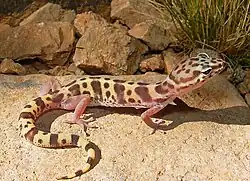
The western banded gecko (Coleonyx variegatus) is a species of lizard in the family Eublepharidae. The species is native to the southwestern United States and adjacent northwestern Mexico. Five subspecies are recognized. (Full article...) -
 Image 16
Image 16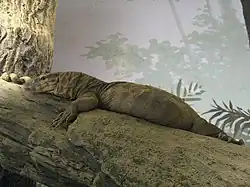
The yellow monitor (Varanus flavescens) or golden monitor is a monitor lizard native to South Asia. (Full article...) -
 Image 17
Image 17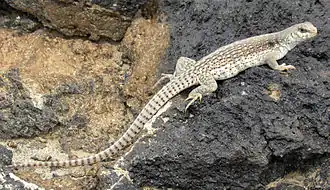 A desert iguana near Amboy Crater, California
A desert iguana near Amboy Crater, California
The desert iguana (Dipsosaurus dorsalis) is an iguana species found in the Sonoran and Mojave Deserts of the Southwestern United States and northwestern Mexico, as well as on several Gulf of California islands. (Full article...) -
 Image 18
Image 18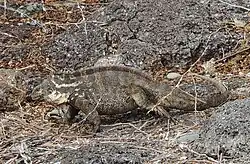 Hybrid iguana near the boat landing on South Plaza Island
Hybrid iguana near the boat landing on South Plaza Island
The hybrid iguana is a first-generation hybrid, the result of intergeneric breeding between a male marine iguana (Amblyrhynchus cristatus) and a female Galapagos land iguana (Conolophus subcristatus) on South Plaza Island in the Galápagos Islands, where the territories of the two species overlap. (Full article...) -
 Image 19
Image 19
Draco volans, also commonly known as the common flying dragon, is a species of lizard in the family Agamidae. The species is endemic to Southeast Asia. Like other members of genus Draco, this species has the ability to glide using winglike lateral extensions of skin called patagia. (Full article...) -
 Image 20
Image 20
The Transvaal dwarf chameleon (Bradypodion transvaalense) is a chameleon native to South Africa, where it is found in forested areas of Mpumalanga and Limpopo provinces. It is also known as the Wolkberg dwarf chameleon, after the Wolkberg range. (Full article...) -
 Image 21
Image 21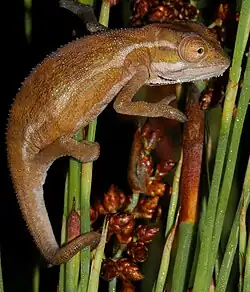
Smith's dwarf chameleon (Bradypodion taeniabronchum), also known as the Elandsberg dwarf chameleon, is a species of lizard in the family Chamaeleonidae endemic to Fynbos in South Africa's Eastern Cape. As in several species of chameleons in the genus Bradypodion, the Smith's dwarf chameleon can use its color-changing ability to actively camouflage itself depending on the vision of the specific predator species (for example, bird or snake) by which it is being threatened. (Full article...) -
 Image 22
Image 22
Hemidactylus, from Ancient Greek ἡμι- (hēmi-), meaning "half", and δάκτυλος (dáktulos), meaning "finger", is a genus of the common gecko family, Gekkonidae. It has 194 described species, newfound ones being described every few years. These geckos are found in all the tropical regions of the world, extending into the subtropical parts of Africa and Europe. They excel in colonizing oceanic islands by rafting on flotsam, and are for example found across most of Polynesia. In some archipelagoes, cryptic species complexes are found. Geckos like to live in and out of houses. They have been introduced to many areas around the world. (Full article...) -
 Image 23
Image 23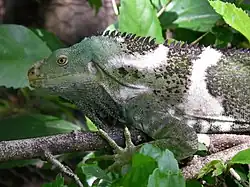 In the Melbourne Zoo
In the Melbourne Zoo
The Fiji crested iguana or Fijian crested iguana (Brachylophus vitiensis) is a critically endangered species of iguana native to some of the northwestern islands of the Fijiian archipelago, where it is found in dry forest on Yadua Taba (west of Vanua Levu), Yadua, Macuata, Yaquaga, Devuilau (Goat island), Malolo, Monu and Monuriki. (Full article...) -
 Image 24
Image 24.jpg)
The clouded monitor (Varanus nebulosus) is a species of monitor lizard, native to Myanmar, Thailand and Laos, Vietnam, to West Malaysia, Singapore, Sumatra, and Java. They are excellent tree climbers. It belongs to the subgenus Empagusia along with the Bengal monitor, the Dumeril's monitor and other monitor lizards. It had previously been listed as a subspecies of Bengal monitor by some herpetologists. It is a diurnal monitor. (Full article...) -
 Image 25
Image 25.jpg) An adult green iguana in Costa Rica
An adult green iguana in Costa Rica
The green iguana (Iguana iguana), also known as the American iguana or the common green iguana, is a large, arboreal, mostly herbivorous species of lizard of the genus Iguana. Usually, this animal is simply called the iguana. The green iguana ranges over a large geographic area; it is native from southern Brazil and Paraguay as far north as Mexico. (Full article...)
Categories

Selected turtle articles
-
 Image 1
Image 1
The Yucatán box turtle (Terrapene yucatana) is a species of box turtle endemic to Mexico. It is sometimes treated as a subspecies of Terrapene carolina. (Full article...) -
 Image 2
Image 2.jpg)
Aubry's flapshell turtle (Cycloderma aubryi) is a species of softshell turtle in the family Trionychidae. The species is endemic to Central Africa. (Full article...) -
 Image 3
Image 3.jpg) Terrapene mexicana
Terrapene mexicana
The Mexican box turtle (Terrapene mexicana) is a species of box turtle belonging to the family Emydidae. It is sometimes treated as a subspecies of Terrapene carolina (Terrapene carolina mexicana). (Full article...) -
 Image 4Black turtle may refer to: (Full article...)
Image 4Black turtle may refer to: (Full article...) -
 Image 5
Image 5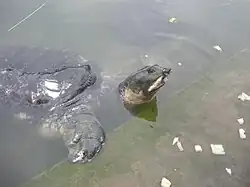
The black softshell turtle or Bostami turtle (Nilssonia nigricans), previously placed in genus Aspideretes, is a species of freshwater turtle found in India (Assam and Tripura) and Bangladesh (Chittagong and Sylhet). It was long believed to consist of inbred individuals of the Indian softshell turtle (A. gangeticus or N. gangeticus) or the Indian peacock softshell turtle (A. hurum or N. hurum), but while it is a close relative of the latter, it is a distinct species. (Full article...) -
 Image 6
Image 6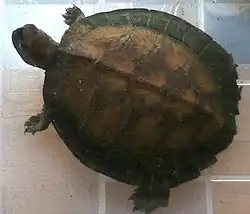
Cyclemys enigmatica, also known as the enigmatic leaf turtle, is a species of Asian leaf turtle. It is found in the Greater Sunda Islands and the Malay Peninsula. (Full article...) -
 Image 7
Image 7
The Bellinger River turtle (Myuchelys georgesi), or Bellinger River saw-shelled turtle, is a species of turtle in the family Chelidae. The species is of moderate size, with a straight-line carapace length to 240 mm (9.4 in) in females, and 185 mm (7.3 in) in males. It is endemic to Australia with a highly restricted distribution to the small coastal drainage of the Bellinger River in New South Wales. (Full article...) -
 Image 8
Image 8_on_the_road_-_second_encounter_with_this_rare_species_discovered_by_science_as_late_as_1984_..._(31018867553).jpg)
The big-headed pantanal swamp turtle or pantanal swamp turtle (Acanthochelys macrocephala) is a species of turtle in the family Chelidae found in Brazil, Bolivia, Argentina, and Paraguay. (Full article...) -
 Image 9
Image 9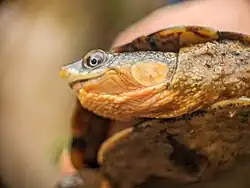
Vanderhaege's toad-headed turtle (Mesoclemmys vanderhaegei) is a species of turtle in the family Chelidae. The species is endemic to South America. (Full article...) -
 Image 10
Image 10
The East African black mud turtle (Pelusios subniger), also known as the Pan terrapin, is a species of turtle in the family Pelomedusidae, native to eastern and southeastern Africa. (Full article...) -
 Image 11
Image 11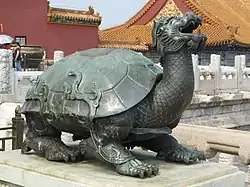
A statue of a dragon turtle in China
A dragon turtle (Chinese : 龍龜, pinyin : Lóngguī) is a legendary Chinese creature that combines two of the four celestial animals of Chinese mythology: the shell of a turtle with a dragon's body is promoted as a positive ornament in Feng Shui, symbolizing courage, determination, fertility, longevity, power, success, and support. Decorative carvings or statuettes of the creature are traditionally placed facing the window. (Full article...) -
 Image 12The Sulawesi forest turtle (Leucocephalon yuwonoi) is a critically endangered species of turtle in the family Geoemydidae. The species is monotypic within the genus Leucocephalon. It is endemic to Sulawesi in Indonesia. These turtles have a unique clutch size, which is 1 or 2 eggs per clutch, that is significantly less than an average turtle's clutch size. (Full article...)
Image 12The Sulawesi forest turtle (Leucocephalon yuwonoi) is a critically endangered species of turtle in the family Geoemydidae. The species is monotypic within the genus Leucocephalon. It is endemic to Sulawesi in Indonesia. These turtles have a unique clutch size, which is 1 or 2 eggs per clutch, that is significantly less than an average turtle's clutch size. (Full article...) -
 Image 13
Image 13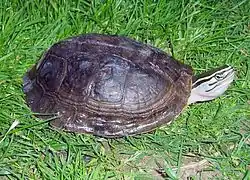 Adult C. a. amboinensis from Sulawesi
Adult C. a. amboinensis from Sulawesi
The Amboina box turtle or Southeast Asian box turtle (Cuora amboinensis) is a species of Asian box turtle widely distributed across Southeast Asia. It is native to the Asian mainland from northeast India, through Bangladesh, Burma and Thailand, across Laos, Cambodia, Vietnam, and Malaysia. It is also found on the archipelagos of Indonesia and the Philippines. (Full article...) -
 Image 14The lesser Chinese softshell turtle (Pelodiscus parviformis) is a species of turtle in the family Trionychidae. It is endemic to China, where it inhabits a small range in Guangxi and Hunan provinces. Populations of this species in Vietnam and Hainan are now considered to belong to a separate species, the spotted softshell turtle (P. variegatus). (Full article...)
Image 14The lesser Chinese softshell turtle (Pelodiscus parviformis) is a species of turtle in the family Trionychidae. It is endemic to China, where it inhabits a small range in Guangxi and Hunan provinces. Populations of this species in Vietnam and Hainan are now considered to belong to a separate species, the spotted softshell turtle (P. variegatus). (Full article...) -
 Image 15
Image 15_(9620525421).jpg) Photographed at Berenty Reserve
Photographed at Berenty Reserve
The Madagascan big-headed turtle (Erymnochelys madagascariensis) is a turtle native to the waters of permanent slow moving rivers and lakes in western Madagascar. These turtles are critically endangered and have been evaluated to be the most endangered turtle in the world by a 2018 review. Due to its ancient origins and threatened status, it is ranked as #1 on the EDGE of Existence programme's list of priority reptiles. (Full article...) -
 Image 16
Image 16 Amboina box turtle, Cuora amboinensis
Amboina box turtle, Cuora amboinensis
Asian box turtles are turtles of the genus Cuora in the family Geoemydidae. About 12 extant species are recognized. The keeled box turtle (Pyxidea mouhotii syn. Cuora mouhotii) is often included in this genus, or separated in the monotypic genus Pyxidea. Genus Cuora is distributed from China to Indonesia and the Philippines, throughout mainland Southeast Asia, and into northern India and Bhutan. (Full article...) -
 Image 17
Image 17_Daintree.jpg) Daintree rainforest, Queensland
Daintree rainforest, Queensland
The saw-shelled turtle (Myuchelys latisternum) is a species of turtle in the Chelidae family endemic to Australia, ranging along rivers and streams and connected swamps and lagoons from coastal Cape York Peninsula to northern New South Wales, with populations also noted as far south as Newcastle - (Williams River Catchment site of the former Tilligra Dam). They are thought to have been introduced to Lake Eacham in the Atherton Tablelands. Other common English names are: serrated snapping turtle or common sawshell turtle. (Full article...) -
 Image 18
Image 18_crossing_the_road_..._(52075448721).jpg) In Tunisia
In Tunisia
The European pond turtle (Emys orbicularis), also called commonly the European pond terrapin and the European pond tortoise, is a species of long-living freshwater turtle in the family Emydidae. The species is endemic to the Western Palearctic. (Full article...) -
 Image 19
Image 19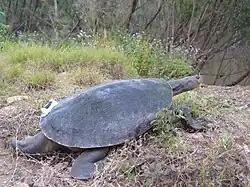 In Queensland, Australia
In Queensland, Australia
The Mary River turtle (Elusor macrurus) is an endangered species of short-necked turtle in the family Chelidae. The species is endemic to the Mary River in south-east Queensland, Australia. Although this turtle was known to inhabit the Mary River for nearly 30 years, it was not until 1994 that it was recognised as a new species. There has been a dramatic decrease in its population due to low reproduction rates and an increase of depredation on nests. (Full article...) -
 Image 20
Image 20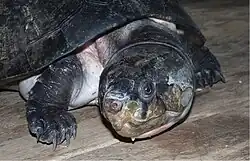
The Big-headed Amazon River turtle (Peltocephalus dumerilianus), also known as the big-headed sideneck, is a species of turtle in the family Podocnemididae. (Full article...) -
 Image 21
Image 21.jpg) Chicken turtle on land
Chicken turtle on land
The chicken turtle (Deirochelys reticularia) is a turtle native to the southeastern United States. It is the only extant member of the genus Deirochelys and is a member of the freshwater marsh turtle family Emydidae. The chicken turtle's scientific name refers to its extremely long neck and distinctive net-like pattern on its upper shell. There are three regionally distinct subspecies (eastern, western and Florida), which are thought to have evolved when populations became separated during periods of glaciation. These subspecies can be distinguished by their appearance; the western chicken turtle displays dark markings along the seams of its plastron (lower shell), while the plastron of the Florida subspecies is a bright yellow or orange color. Fossil records show that the chicken turtle has been present in the region for up to five million years. (Full article...) -
 Image 22
Image 22
The Indian narrow-headed softshell turtle (Chitra indica), also known as the small-headed softshell turtle or the Indo-Gangetic softshell turtle, is an endangered species of softshell turtle native to waterways and rivers of the Indian subcontinent. It is very large (being one of the largest freshwater turtles), feeding on fish, frogs, worms, crustaceans and molluscs, and even the occasional swimming small rodent or other mammal. C. indica, like other softshell turtles, uses it flexible (and somewhat leathery) shell to dig itself deep into sandy lake and river bottoms; here, it patiently waits (with just its nose, mouth and eyes exposed) for potential prey to swim by. They will also ambush and chase their prey, depending on availability, the time of year, and size of the prey. In the past it was included as a subspecies of Chitra chitra, a species restricted to Southeast Asia using current taxonomy. (Full article...) -
 Image 23
Image 23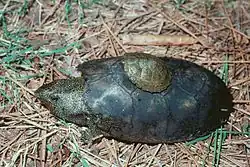 Adult and hatchling
Adult and hatchling
The flattened musk turtle (Sternotherus depressus) is a critically endangered species of freshwater turtle in the family Kinosternidae. The species is endemic to north-central and west-central Alabama. (Full article...) -
 Image 24The African dwarf mud turtle (Pelusios nanus) is a species of turtle in the family Pelomedusidae. It is endemic to Africa : in Angola, the Democratic Republic of the Congo, Malawi, and Zambia. These mud turtles are the smallest of all African turtle species, “Nanus” which they are referred to are one of the 3 smallest turtle species in the world. The other two are Stink Pot Musk and Muhlenberg's Bog Turtles. All 3 species barely reach 4 inches as full grown adults. Like many of the world's chelonians, Pelusios castaneus has the potential to live a long life. Reports typically suggest more than 50 years in captivity for this species. (Full article...)
Image 24The African dwarf mud turtle (Pelusios nanus) is a species of turtle in the family Pelomedusidae. It is endemic to Africa : in Angola, the Democratic Republic of the Congo, Malawi, and Zambia. These mud turtles are the smallest of all African turtle species, “Nanus” which they are referred to are one of the 3 smallest turtle species in the world. The other two are Stink Pot Musk and Muhlenberg's Bog Turtles. All 3 species barely reach 4 inches as full grown adults. Like many of the world's chelonians, Pelusios castaneus has the potential to live a long life. Reports typically suggest more than 50 years in captivity for this species. (Full article...) -
 Image 25
Image 25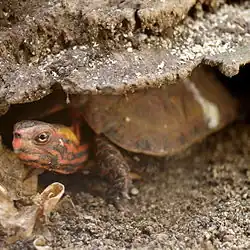
The Ryukyu black-breasted leaf turtle or Ryukyu leaf turtle (Geoemyda japonica) is a species of turtles in the family Geoemydidae (formerly Bataguridae) endemic to the Ryukyu Islands in Japan. In 1975, the species was designated a National Natural Monument of Japan. It grows to about 5–6 inches long. In captivity, it feeds on worms, snails, insects, and fruit. Due to its rarity and very attractive appearance, this species is highly coveted by turtle collectors worldwide. (Full article...)
Need help?
Do you have a question about Reptiles that you can't find the answer to?
Consider asking it at the Wikipedia reference desk.
Topics
Major extant reptile clades | |||||
|---|---|---|---|---|---|
| Lepidosauria | |||||
| Archelosauria |
| ||||
Related portals
Associated Wikimedia
The following Wikimedia Foundation sister projects provide more on this subject:
-
Commons
Free media repository -
Wikibooks
Free textbooks and manuals -
Wikidata
Free knowledge base -
Wikinews
Free-content news -
Wikiquote
Collection of quotations -
Wikisource
Free-content library -
Wikiversity
Free learning tools -
Wiktionary
Dictionary and thesaurus
-
 List of all portals
List of all portals -

-

-

-

-

-

-

-

-

-
 Random portal
Random portal -
 WikiProject Portals
WikiProject Portals

.jpg)
